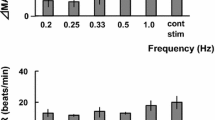Abstract
Intravenous injection of purified scorpion toxin (tityustoxin, TsTX) brings about the appearance of salivary flow and of kallikrein and amylase secretion in the saliva of rats. In experiments performed in vitro, using slices of parotid gland, a dose-response curve correlating tityustoxin concentration with kallikrein and amylase activities was obtained. The secretion of kallikrein is slower and smaller than that of amylase after up to 60 min of incubation. Experiments in which propranolol, phenoxybenzamine or atropine were injected into rats or added to parotid gland slices showed that the release of kallikrein is more dependent on cholinergic mechanisms, whereas the release of amylase is mainly related to adrenergic effects. Pre-treatment of the animals with reserpine confirms these results. The actions of tityustoxin on the kallikrein and amylase secretions, per min, are more effective than those by pilocarpine and isoproterenol, respectively.
Similar content being viewed by others
References
O. Magalhães,Escorpionismo, Monog. Inst. Oswaldo Cruz3, 1–220 (1946).
C.R. Diniz andV. Valeri,Effects of a Toxin Present in a Purified Extract of Telson from the Scorpion Tityus serrulatus on Smooth Muscle Preparation and in Mice, Arch. int. pharmacodyn.71, 1–13 (1959).
C.A. Schneyer andH.D. Hall,Secretory Mechanism of Salivary glands (Academic Press, 1967).
K.D. Bhoola, P.F. Heap andM.J.C. Lemon,The Regulation of Kallikrein Secretion from Isolated Submandibular Gland Slices by neurotransmitters, Cyclic Nucleotides and Calcium, Adv. Exper. Med. and Biol. (Eds. F. Sicuteri, N. Back and G.L. Haberland)70, 59–64 (1976).
C.R. Diniz andJ.M. Gonçalves,Some Chemical and Pharmacological Properties of Brazilian Scorpion Venom, in:Venoms (Eds. E. Buckley and N. Porges; Am. Assoc. Adv. Science, 1956), pp. 131–144.
A.P. Corrado, A. Antonio andC.R., Diniz,Brazilian Scorpion Venom (Tityus serrulatus) an Unusual Sympathetic Postganglionic Stimulant, J. Pharmac. exp. Ther.164, 253–258 (1968).
L. Freire-Maia, J.R. Cunha-Melo, H.A. Futuro-Neto, A.D. Azevedo andJ. Weinberg,Cholinergic and Adrenergic Effects of Tityustoxin, Gen. Pharmac.7, 115–121 (1976).
L. Freire-Maia, J.R. Cunha-Melo, M.V. Gomez, W.L. Tafuri, T.A. Maria, S.L. Calixto andH.A. Futuro-Neto,Studies on the Mechanism of Action of Tityustoxin, in:Animal, Plant and Microbial Toxins, vol. 2 (Ed. A. Ohsaka; 1976), pp. 273–285.
L. Freire-Maia, G.I. Pinto andI. Franco,Mechanism of the Cardiovascular Effects Produced by Purified Scorpion Toxin in the Rat, J. Pharmac. exp. Ther.188, 207–213 (1974).
O.L. Catanzaro, J.R. Cunha-Melo, R.A.S. Santos, R. Santos, L. Freire-Maia andW.T. Beraldo,Influência da Tityustoxina sobre o fluxo salivar, amilase e proteína na glândula parótida in vivo, Ciênc. Cult. São Paulo28 (Suppl.), 552 (1976).
R.A.S. Santos, R. Santos, O.M. Parra, W.T. Beraldo, L. Freire-Maia andO.L. Catanzaro,Estudo comparativo da secreção de calicreina e amilase na glândula parótida pela tityustoxina, pilocarpina e isoproterenol, Ciênc. Cult. São Paulo28 (Suppl.), 552 (1976).
W.T. Beraldo, R.L. Araujo andM. Mares-Guia,Oxytocic Esterase in Rat Urine, Am. J. Physiol.211, 975–980 (1966).
K. Nusted andJ.V. Pierce,Purification of Rat Urinary Kallikreins and their Specific Antibody, Biochemistry13, 2312–2319 (1974).
V.C. Myers, A.H. Free andE.E. Rosinski,Studies on Animal Diastase. VI. The Determination of Diastase (Amylase) in Blood, J. Biol. Chem.154, 39 (1944).
O.H. Lowry, N.J. Rosebrough, A.L. Farr andR.J. Randall,Protein Measurement with the Folin-Phenol Reagent, J. Biol. Chem.193, 265–275 (1951).
M.V. Gomez andC.R. Diniz,Separation of Toxic Components from Brazilian Scorpion Tityus serrulatus Venom, Mems. Inst. Butantan33, 899–902 (1966).
C.R. Diniz andJ.M. Torres,Release of an Acetylcholine-Like Substance from Guinea-Pig Ileum by Scorpion-Venom, Toxicon5, 277–281 (1968).
M.V. Gomez, M.E.M. Dai andC.R. Diniz,Effect of Scorpion Venom, Tityustoxin, on the Release of Acetylcholine from Incubated Slices of Rat Brain J. Neurochem.20, 1051–1061 (1973).
M.C. Henriques, G. Gazzinelli, C.R. Diniz andM.V. Gomez,Effect of the Venom of the Scorpion Tityus serrulatus on Adrenal Gland Catecholamines, Toxicon5, 175–179 (1968).
J. Moss, T. Kazic, D.P. Henry andI. Kopin,Scorpion Venom Induced Discharge of Catecholamines Accompanied by Hypertension, Brain Res.54, 381–385 (1973).
J.R. Cunha-Melo, L. Freire-Maia, W.L. Tafuri andT.A. Maria,Mechanism of Action of Purified Scorpion Toxin on the Isolated Rat Intestine. Toxicon11, 81–84 (1973).
Author information
Authors and Affiliations
Rights and permissions
About this article
Cite this article
Catanzaro, O.L., Santos, R.A.S., Parra, O.M. et al. Effect of scorpion toxin (tityustoxin, TsTx) on the salivary gland of the rat, in vivo and in vitro. Agents and Actions 8, 119–124 (1978). https://doi.org/10.1007/BF01972413
Issue Date:
DOI: https://doi.org/10.1007/BF01972413




